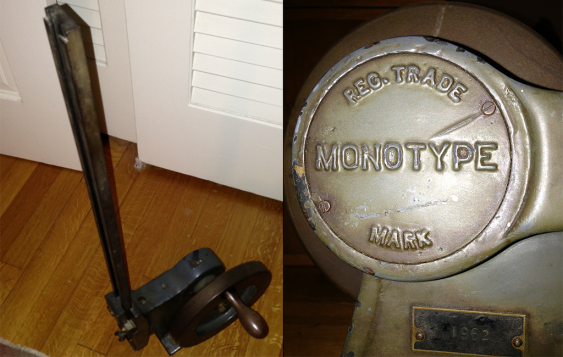An Amazing, Wonderful, Forgotten Tool

The Monotype Space Maker (Sidney E. Berger).
I know what it means to be out of sorts. As a young printer in the 1970s I was setting up my own press. I ordered Bembo in two sizes and the spacing material and got started. One of my first projects was a wonderful poem by Thom Gunn, Lament, that I turned into a small book. It was about 150 lines, and I ran out of word spaces—3-to-ems. I tried 4-to-ems, but that set the words too tightly, and I didn’t want to have to use thins (like a brass or two coppers) to make up the added space. The only solution was to call the foundry from whom I had bought the type and get some more spaces. It took time for my check to get to them, and time for the spacing matter to get to me, and in the meantime I walked past my press a dozen times wishing I could get to work.
This sounds odd now: waiting for spaces. But since I was in the process of setting up my press, I was gathering all the materials I needed, and only through experience does one find out what one needs. Nearly two decades later I acquired a tool that would have saved me the trouble of having to call the foundry and the time it took to get the type. That tool was a space maker.
This is a pretty rare tool that even some seasoned letterpress printers have never seen—or even heard of. I have seen only two of these in a half century, my own, and one at Stinehour Press in Vermont. A discussion with Steve Stinehour was illuminating, but only minimally. He had used one years ago at the Stinehour Press, but he had not seen another. Mark Barbour of the International Printing Museum in Carson, California, had once used one at the place of a type caster, but the museum itself did not have one.
The tool is about 25 inches high, 9 inched deep, and 4 ½ inches wide, not counting the protruding handle, which adds another 3 inches to its width. The high part contains a channel into which will slide a thin (brass, copper, or steel) or a lead (1-, 2-, or 3-point). Once the thin or lead is sitting vertically in the channel, a piece of heavy steel slides down into that channel, on top of the other strip, pressing it down. At the bottom of the channel is an adjustable flange that moves up or down once it is released with a wing nut, so the operator can adjust the cutting aperture to whatever point size she wishes. If the spaces are to be 12-point, you can put a 12-point piece of type in the bottom of the machine and adjust the flange to that measure. Then you tighten the wing nut and you are ready to make 12-point spaces.
There is a heavy solid steel wheel on the side, with a handle. Turn the handle, and a cutting blade cuts off a piece of the vertical slug that protrudes at the bottom of the channel exactly 12 points, creating a piece of spacing. The little weight that sits in the channel on top of the lead pushes the lead down to expose the bottom of the lead another 12 points, and the turning wheel rotates the blade that cuts off another piece of the lead. The faster you spin the wheel, the faster the spaces come spurting out the bottom of the tool.
As I mentioned, the wheel is quite heavy, and the handle is cast as part of it. When you get it spinning fast, you can let it go and it will keep spinning, cutting another ten or more spaces on its own, since the wheel will turn a good deal till it stops by itself. Once the lead is used up (or, in this case, used down!), the channel will be empty, and you can take out the weight, put another lead into the channel, replace the weight, and keep going. With enough leads, you can make a great pile of spaces in short order.
The space maker that I have has cast into its side the name Monotype, around which are cast “REG. TRADE MARK.” Beneath this, on another part of the tool, is a small brass plate with “1962” on it. There is no other marking of any kind on the device. I assume that this is a date, though I suspect that the invention of this tool goes back before the 1960s. What is so frustrating for me, however, is that there is no indication of patent protection on it, nor can I find a thing about it on the Web.
In the mid-twentieth century when commercial letterpress printing was grinding to a halt (though it never fully halted), and with letterpress shops either closing down or converting to photo composition, to offset, and then to computer printing, the need for such a tool dries up. I am sure that many of these solid steel machines were melted down to make other things. It does not surprise me that there are not many of them around today. I am interested in knowing how many space maker machines are still in use and would compile a census if people were to let me know.
